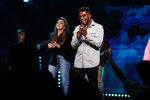
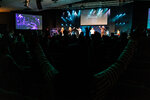
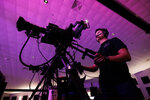
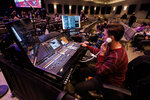
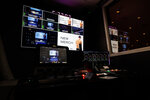

The website Church Executive, which covers the leadership and business side of Christian churches, surveyed in late 2021 nearly 2,000 Christian church leaders across the United States about their church’s use of technology, purchasing habits, and perspective on the place of tech in the religious space.
The survey found that 93% of churches “believe technology plays an important role in achieving their church’s mission.” There were differences in what part of tech was more important, how often they re-evaluated their tech needs, and what the future holds for tech and church — but the near-consensus was that technology was crucial.
James Lewis, the executive pastor of operations at Manna Church in Fayetteville, works at a non-denominational church where technology is crucial to its ministry. To him, he says, it’s part of taking advantage of a world where technology is rapidly evolving and the internet is a cornerstone of people’s lives.
“Why would we exclude the technical aspects of the modern in anything that we did?” Lewis asks.
While Manna Church’s multi-campus model and vibrant online presence are a relative norm for the Christian space nowadays, other religions and congregations, in Fayetteville and beyond, take a different approach. While the approaches may be different, Manna Church, the Islamic Center of Fayetteville, and the Jewish synagogue Beth Israel Congregation have two things in common: technology is both part of what they do and not the end-all, be-all that it has become in many aspects of American society.
Practicing salat in Fayetteville
At 1:30 p.m. on Fridays, the Islamic Center of Fayetteville (ICF) conducts its Jummuah Salat. This weekly gathering is a congregational worship based on a commandment from the Quran: “O Believers! When the call to prayer is made on the day of congregation, hurry towards the reminder of God and leave off your business — that is better for you, if only you knew!” There are two parts of this gathering: “salat,” the ritual prayers, and “khutbah,” a sermon delivered during Friday prayers.
The ICF uses its website to serve as a “da’wah” — the Arabic word meaning to “invite” or “summon someone” — for the Islam community in Fayetteville and those visiting to join the Jummuah Salat. The website provides information on where to attend and what time the service is, as well as recordings of past khutbahs.
“We record some of our lectures, we connect them to our YouTube channel, and then we’re able to put the link on our website,” says David Haskins, chairman of the ICF. “So if somebody wants to see our Friday lecture, then they can see that, they can see firsthand what we say on the podium when we were up there.”
The website also serves as an educational introduction to Islam. Visitors can find information on better understanding Islam — one of the center’s stated priorities — like “Allah’s 99 Beautiful Names,” instructions on various types of prayers, and a link to prayer times in Fayetteville.
Daily prayer is among one of the Five Pillars of Islam, known as “arkān al-Islām.” There are five times of prayer: before sunrise, just after noon, late afternoon, just after sunset, and at night. The ICF’s website connects visitors to the website Islamic Finder, which gives accurate prayer times, down to the minute with a countdown clock, for cities across the world.
“During the summer months, the days are longer,” Haskins says. “So the prayer times that we have — the five daily prayers — change in the winter month, they’re closer together. And for example, the prayer times in New York, because of the difference in geography is going to be different than the prayer times here in Fayetteville.”
Like many religious organizations and churches, the website also has a calendar of events and important announcements. The ICF also has a Facebook page where it primarily shares YouTube links to its khutbahs.
Morning Manna and the broadcast service
Every morning (with the exception of Sundays) at 5:30 a.m., the Manna Church Facebook page plays host to Morning Manna, a series of videos where a staff member provides a short message on a spiritual topic. The videos are usually around three minutes long and shot in a room with a table, lamp, and potted plant. The speaker sits behind the table and speaks directly into a microphone, looking at the camera.
It’s just one of the many ways that Manna Church uses technology and the internet to not only connect with its own members, but the community at large.
Manna Church’s primary location is a two-building campus on Cliffdale Road, but the church also has five other campuses — Anderson Creek in Spring Lake, Executive Place in Fayetteville, Ramsey Street in Fayetteville, Raeford, and Hope Mills. This, along with other planted churches and smaller groups that meet across the country, explain the church’s primary statement of “One Church, Many Locations,” James Lewis says.
“We have way too many people that would fit here,” says Lewis, speaking of the church’s 8,000-member congregation and regular attendance of around 4,500 people. “We’d have services all doggone day and it would all be packed. Keeping everything within the churchgoing time would require us to be at different places and different sites. So growth kind of helped us develop that.”
While the Cliffdale and Executive Place locations have live preaching and music, the other four locations are run a little differently. Lewis explains that the other four have live hosting and live music, using the same setlist as the main campus, but through video messages. The messages are recorded on Thursday evenings at the Cliffdale location in what’s called a “capture service.” This service is shared on the church’s website and the file is sent to the other churches under the Manna banner.
These video services have the trappings of many non-traditional churches today: a worship band with multiple instruments, backed by a screen with the lyrics, and a pastor wearing a wireless microphone and Bible verses visible as they read them. Lewis says the church uses five to six cameras to capture the services and utilizes a service director to put the package together.
“It’s just really a camera recording or it’s live and going through a switcher,” Lewis says. “Just think of it as, ‘Hey, the news is playing, sports is playing.’ You have somebody who’s directing who says, ‘Go this camera, this camera.’”
The multi-site model has its fair share of critics in the Christian community, and Lewis says he’s heard it all, primarily about video-recorded sermons. He acknowledges that it’s not for everybody, and that’s OK, and Manna will be happy to direct churchgoers to a more traditional church if that’s what they’re looking for.
But what Manna is trying to do — not just with its lights and fog machines and video packages — is engage people in an experience, Lewis says.
“We create an atmosphere where people can experience the Holy Spirit. All of that feeds into that thing,” he says. “We’re not doing it just so you can see how amazing our worship leaders are or how amazing our tech people are. We want to create an experience. If we’re doing it right, those things become secondary.”
Honoring Shabbat
Two weeks before the world “shut down” due to Covid-19, Rabbi Dov Goldberg of Beth Israel Congregation received a webcam in the mail. Talk about timing.
The Congregation began to livestream its Shabbat services, taking one week off to get the technology up and running. It still does to this day, but there’s an important asterisk that makes what Beth Israel does quite different from what Manna Church does.
The Mishnah is a collection of Jewish oral tradition and rabbinic literature, the first of its kind, that provide guidance to Jews across the world on a number of subjects. One of the components of the Mishnah is the 39 categories of “melacha” (work) prohibited on the Sabbath, the day of Jewish worship held on Saturdays. Among them are sowing, plowing, grinding, tying a knot, cutting, writing, and building.
One of the most prominent, particularly when it comes to the use of technology, is extinguishing or kindling a fire. Goldberg and his congregation follow a relatively conservative approach to Jewish law. He says that Jews should not start an electronic device or use it on Shabbat, but can take advantage of something already on.
“According to traditional Jewish law, you’re not permitted to light, extinguish or manipulate fire on Shabbat,” Goldberg says. ‘But if you’ve got a fire going in your fireplace, you can use it. You can’t add wood to it, but you can’t start it once Shabbat has started. Electricity is more complicated, but we draw it as an analogy.”
The complications that the pandemic posed and the ways in which the synagogue responded have continued to this day. The congregation holds its Shabbat services on Friday evenings and Saturday mornings and will livestream them on Zoom for anyone who is not able to make it to the service. But to adhere to Jewish law, Goldberg will start the stream before Shabbat begins at sunset on Fridays and leave it running throughout the service and until Shabbat ends.
“We’re turning on the device before Shabbat begins,” he says, “and if there’s a problem that doesn’t resolve itself on its own, then sorry, there’s technical difficulties.”
Beth Israel has been using Zoom for other parts of its work as well. Goldberg conducts in-person adult Jewish education classes during the week but also livestreams them on Zoom for those who would rather participate online. He says that the streaming environment is “in some ways … a game changer.”
“It doesn’t change everything and it doesn’t improve everything,” he says. “In some ways, it’s made the game better. In some ways, it’s resulted in some not-great things.”
What technology doesn’t bring
This is a point on which Haskins, Lewis, and Goldberg agree. While technology can be very helpful in certain functions of religious practice and operating a faith group, it cannot and must not be the end-all, be-all. Goldberg says he believes that congregation members should physically be in the room during Shabbat services and that joining virtually “is not actually the same as standing outside through the open window.”
“At a minimum, it changes the dynamic,” he says. “In a certain way, it frequently can undermine some of the great type of interactions that only occur when people are in a room together. When it comes to services, certainly in my mind, the experience is all the more heightened in a worship environment.”
Similar to Goldberg, Haskins says participating in the congregational prayers and the “jumu’ah” (the Arabic word that denotes “coming together”) makes in-person attendance vital.
“The collective congregational prayer is an in-person event,” he says. “That’s what I wanted to mention. If [you’re] not [in-person], you really can’t say that you’ve participated in it because you’re watching it on TV now.”
Lewis says that the virtual vision of Manna Church’s services and all the technological pieces that go with it are part of what is expected at churches nowadays, but are designed to lead to something else. He says members are encouraged to plug in to small groups, where members meet to discuss various topics and spend time getting to know each other. The digital space, particularly, fits that model.
“Because technology has been such a part of our lives, going counter-technology is actually counter intuitive,” Lewis says. “As a church, we have to meet people where they are. That’s what God does, he meets people where they are. If that’s where they are, let’s meet them. Doesn’t mean we stay there. We’re going to give you some content, we’re going to engage you, we’re going to chat with you for a little bit, but we’re going to invite you to a physical presence of some sort at some point in time.”
The future of tech in religion
Haskins admits that, in the future, people may look back and think that his congregation may be seen as “outdated” with the mosque’s insistence on in-person gathering.
“But right now, the general philosophy is that it is a congregational prayer that has to be done in person,” he says, “and that you don’t get the same benefit or reward for doing that prayer by watching somebody else doing it on TV.”
Adherence to tradition is commonplace in religion. Lewis says Manna’s approach to technology isn’t exactly prescribed by something in the Bible, but it is guided by long-held principles in Christian thought.
“When we look at Scripture, there’s really two things you have to do within church,” Lewis says. “One is gather and worship together, and two is preach the word of God. We’re doing it [through] video. We have social media. ‘How’ is not a prescriptive thing.”
Ultimately, Manna Church, the Islamic Center of Fayetteville, and Rabbi Dov Goldberg’s Beth Israel Congregation all have that in common. They are using and adapting the modern tools of technology to fulfill their missions and purposes in their communities. Virtual worship isn’t the top choice for any of them, but technology allows for the use of websites, Facebook, Zoom, YouTube, Instagram, and livestreaming to share religious messages, keep members up to date on important events, and educate the public on their various beliefs.
Goldberg, the son of a rabbi of a small synagogue in Vermont, regularly points out the pros and cons of technology. It can be used to keep in touch with congregants who are going through a tough time and send out a reminder email, he says. For example, Beth Israel sends out weekly bulletins with information and “Shabbat Shalom,” a kind of newsletter with thoughts from Goldberg, news articles on current events, and details on upcoming events.
But when it comes to worship and community, in-person, he says, will always be best.
“When it comes to services, certainly in my mind, the experience is all the more heightened in a worship environment,” Goldberg says. “Experientially, my under-standing of worship, everything that we do electronically is a diminution from that.”